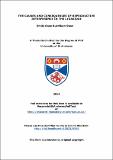Files in this item
The causes and consequences of reproductive interference in the Lygaeidae
Item metadata
| dc.contributor.advisor | Shuker, David M. | |
| dc.contributor.author | Burdfield-Steel, Emily R. | |
| dc.coverage.spatial | 236 | en_US |
| dc.date.accessioned | 2015-04-23T13:20:22Z | |
| dc.date.available | 2015-04-23T13:20:22Z | |
| dc.date.issued | 2012-12-01 | |
| dc.identifier | uk.bl.ethos.644800 | |
| dc.identifier.uri | https://hdl.handle.net/10023/6549 | |
| dc.description | Electronic version excludes material for which permission has not been granted by the rights holder | en_US |
| dc.description.abstract | Reproductive interference occurs when individuals direct sexual behaviours towards other species and this causes a reduction in the fitness of one or both of the participants. While initially considered to be little more than an aberration, reproductive interference is increasingly recognised, not just as a factor in determining species co-existence and community dynamics, but also as an opportunity to further our understanding of sexual selection. In this thesis I investigate the causes and consequences of reproductive interference between several species of true bugs (Order: Hemiptera) in the family Lygaeidae. These species have a polygynandrous mating system, in which both males and females mate multiple times. I found that the interspecific mating attempts often witnessed in these bugs is likely a consequence of this mating system, as potential cues for species discrimination, in the form of cuticular hydrocarbons, are available and can be utilised by the bugs in some contexts. This is further supported by the finding that pre-copulatory selection on factors such as diet and chemical protection are weak in these insects. Furthermore, my work highlights the context-dependant nature of both the fitness costs associated with reproductive interference, and also of the bugs’ intra-specific behaviour. When housed in groups, female Lygaeus equestris did not show consistent fitness losses in response to harassment by either conspecific or heterospecific males, despite previous evidence showing that such males inflict costs on both egg production and longevity when interacting one-to-one. This, combined with the finding that male L. equestris alter their mate-guarding behaviour in the presence of other males, highlights the potential of behavioural flexibility to influence the outcome of inter-species interactions, and the importance of context when attempting to measure phenomena such as reproductive interference. | en_US |
| dc.language.iso | en | en_US |
| dc.publisher | University of St Andrews | |
| dc.subject | Reproductive interference | en_US |
| dc.subject | Sexual selection | en_US |
| dc.subject.lcc | QL523.L9B8 | |
| dc.subject.lcsh | Lygaeidae--Sexual behavior | en_US |
| dc.subject.lcsh | Lygaeidae--Reproduction | en_US |
| dc.subject.lcsh | Competition (Biology) | en_US |
| dc.subject.lcsh | Sexual selection in animals. | en_US |
| dc.title | The causes and consequences of reproductive interference in the Lygaeidae | en_US |
| dc.type | Thesis | en_US |
| dc.type.qualificationlevel | Doctoral | en_US |
| dc.type.qualificationname | PhD Doctor of Philosophy | en_US |
| dc.publisher.institution | The University of St Andrews | en_US |
This item appears in the following Collection(s)
Items in the St Andrews Research Repository are protected by copyright, with all rights reserved, unless otherwise indicated.

